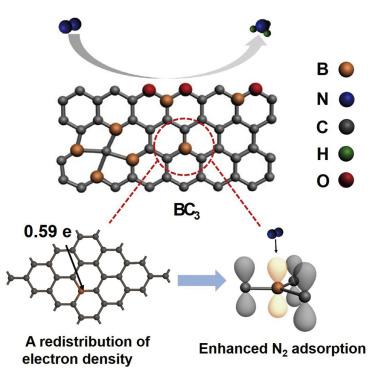Joule ( IF 39.8 ) Pub Date : 2018-06-26 , DOI: 10.1016/j.joule.2018.06.007 Xiaomin Yu , Peng Han , Zengxi Wei , Linsong Huang , Zhengxiang Gu , Sijia Peng , Jianmin Ma , Gengfeng Zheng

|
Electrochemical N2 reduction in aqueous solutions at ambient conditions is extremely challenging and requires rational design of electrocatalytic centers. We demonstrate a boron-doped graphene as an efficient metal-free N2 reduction electrocatalyst. Boron doping in the graphene framework leads to redistribution of electron density, where the electron-deficient boron sites provide enhanced binding capability to N2 molecules. Density functional theory calculations reveal the catalytic activities of different boron-doped carbon structures, in which the BC3 structure enables the lowest energy barrier for N2 electroreduction to NH3. At a doping level of 6.2%, the boron-doped graphene achieves a NH3 production rate of 9.8 μg·hr−1·cm−2 and one of the highest reported faradic efficiencies of 10.8% at −0.5 V versus reversible hydrogen electrode in aqueous solutions at ambient conditions. This work suggests the strong potential of atomic-scale design for efficient electrocatalysts for N2 reduction.
中文翻译:

硼掺杂石墨烯用于电催化还原N 2
在环境条件下水溶液中的电化学N 2还原极具挑战性,需要合理设计电催化中心。我们证明了硼掺杂的石墨烯作为一种有效的无金属的N 2还原电催化剂。石墨烯骨架中的硼掺杂导致电子密度的重新分布,其中缺电子的硼位点增强了与N 2分子的结合能力。密度泛函理论计算揭示了不同掺杂硼的碳结构的催化活性,其中BC 3结构使N 2电还原为NH 3的最低能垒。相对于可逆氢电极,在6.2%的掺杂水平下,硼掺杂的石墨烯的NH 3产生速率为9.8μg·hr -1 ·cm -2,在-0.5 V时,报道的法拉第效率最高,为10.8%。在环境条件下的水溶液。这项工作表明原子尺度设计对于有效的N 2还原电催化剂具有很大的潜力。


























 京公网安备 11010802027423号
京公网安备 11010802027423号